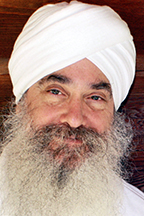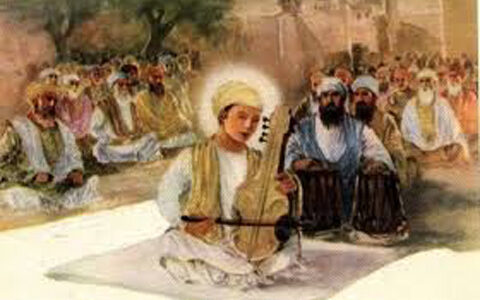by SS Dr. Sham Rang Singh Khalsa, Millis MA
Fall 2012
Hearts are so easily broken: the loss of loved ones, the unfulfilled longing for that perfect partner, the betrayals from those who were dear to us, hopes and expectations dashed. And so often we do not know how to cope, what to do to change things or ourselves, or how to mend.
In Sikh history, the story of Guru Arjan has shown us a way. Guru Ram Das had sent his youngest son Arjan far away, with instructions not to return until called for. Arjan loved his Guru so deeply that he did not hesitate when called to travel to a distant city. His choice to serve his Guru was clear, despite the pain of separation.
Usually when we are faced with painful experiences, we think about the situation in order to find a solution or we look to others for sympathy. We may feel sorry for ourselves and our predicament. Such mental processing can prevent the deeper experience of the situation itself.
Arjan chose to deeply feel his longing and to creatively express it in poetry. In the first part of the bani of Shabd Hazare, Mera Man Loche, the young boy Arjan beautifully describes the thirst of his mind for the vision and presence of his Guru. By actually feeling the angst of separation, his desire for union increased and helped him to focus upon this vision of his Beloved Guru.
The Deepest Love
 After sending this poem off to his Guru and not hearing back from him, he delved more deeply into his pain. His longing for his Guru was so complete that he himself disappeared into this inner vision, sacrificing personal identity to reach so deeply. Within the experience of this pain, he actually saw his Guru’s face in all its beauty.
After sending this poem off to his Guru and not hearing back from him, he delved more deeply into his pain. His longing for his Guru was so complete that he himself disappeared into this inner vision, sacrificing personal identity to reach so deeply. Within the experience of this pain, he actually saw his Guru’s face in all its beauty.
With the second poem also unacknowledged, Arjan’s longing reached a darkness of despair. He wrote of being unable to endure the separation, his chest bursting with this love and longing.
When this third poem finally found its way to the Guru (bypassing the treachery of his eldest brother), Guru Ram Das immediately recognized Arjan’s devotion and called him to his court, crowning him as the next Guru. In the fourth poem of the shabd, Arjan expressed his joy and delight in this reunion.
So, consider this: the broken heart fully experienced brought Arjan to the deepest love. It was because of Arjan’s complete willingness to embrace this separation that he merged into his Guru and actually became Guru. In fact, the written expression of the pain in his beautiful poetry eventually became part of the Siri Guru Granth Sahib.
Guru Arjan has shown us that the answer to life’s pain comes through fully embracing the moment, and acknowledging the authentic will of God and Guru. The broken heart is healed through its complete acceptance and embrace. The problem is solved because there never was a problem, only an experience designed by God’s creative intelligence waiting to be fully experienced.
Meditation to Heal the Wounds of Love
The bani, Shabad Hazare, comprises four letters of longing written by Guru Arjan Dev to his father Guru Ram Das. Yogi Bhajan taught that this shabd, merged with the chant Aad Such, is a powerful meditation to heal the wounds of love.
Meditation to Heal the Wounds of Love
COMMENTS: This meditation is meant to bring positive change to your current relationships while removing past pains that have imbedded themselves in your heart and psyche. To start with you can do this meditation for 11 days. As you do it, you will feel clarity and empowerment to make positive change and to begin to experience authentic relationships. You can continue doing this meditation daily for as long as you feel it serves you.
About the Author
 SS Sham Rang Singh Khalsa, MD, SB, Ayurvedic Doctor, is a physician, teacher, and Minister of Sikh Dharma. He holds certifications in Ayurveda, acupuncture, and emergency and internal medicine, and counsels and teaches about mind-body medicine. Sham Rang Singh Khalsa has been a practitioner and teacher of Kundalini Yoga for more than 35 years.
SS Sham Rang Singh Khalsa, MD, SB, Ayurvedic Doctor, is a physician, teacher, and Minister of Sikh Dharma. He holds certifications in Ayurveda, acupuncture, and emergency and internal medicine, and counsels and teaches about mind-body medicine. Sham Rang Singh Khalsa has been a practitioner and teacher of Kundalini Yoga for more than 35 years.


